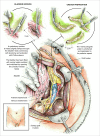Results of a previously unreported extravesical ureteroneocystostomy technique without ureteral stenting in 500 consecutive kidney transplant recipients
- PMID: 33428659
- PMCID: PMC7799771
- DOI: 10.1371/journal.pone.0244248
Results of a previously unreported extravesical ureteroneocystostomy technique without ureteral stenting in 500 consecutive kidney transplant recipients
Abstract
Urologic complications can still occur following kidney transplantation, sometimes requiring multiple radiological and/or surgical procedures to fully correct the problem. Previously proposed extravesical ureteral reimplantation techniques still carry non-negligible risks of the patient developing urologic complications. About 10 years ago, a new set of modifications to the Lich-Gregoir technique was developed at our center, with the goal of further minimizing the occurrence of urologic complications, and without the need for initial ureteral stent placement. It was believed that an improvement in the surgical technique to minimize the risk of developing urologic complications was possible without the need for stent placement at the time of transplant. In this report, we describe the advantages of this technique (i.e., mobilized bladder, longer spatulation of the ureter, inclusion of bladder mucosa with detrusor muscle layer in the ureteral anastomosis, and use of a right angle clamp in the ureteral orifice to ensure that it does not become stenosed). We also retrospectively report our experience in using this technique among 500 consecutive (prospectively followed) kidney transplant recipients transplanted at our center since 2014. During the first 12mo post-transplant, only 1.4%(7/500) of patients developed a urologic complication; additionally, only 1.0%(5/500) required surgical repair of their original ureteroneocystostomy. Five patients(1.0%) developed a urinary leak, with 3/5 having distal ureteral necrosis, and 1/5 subsequently developing a ureteral stricture. Two other patients developed ureteral stenosis, one due to stricture and one due to ureteral stones. These overall results are excellent when compared with other reports in the literature, especially those in which routine stenting was performed. In summary, we believe that the advantages in using this modified extravesical ureteroneocystostomy technique clearly help in lowering the early post-transplant risk of developing urologic complications. Importantly, these results were achieved without the need for ureteral stent placement at the time of transplant.
Conflict of interest statement
The authors have declared that no competing interests exist.
Figures



Similar articles
-
Surgical modifications to the conventional kidney transplant technique: the Miami Transplant Institute approach in a retrospective cohort study.Int J Surg. 2024 Aug 1;110(8):4839-4849. doi: 10.1097/JS9.0000000000001457. Int J Surg. 2024. PMID: 38597387 Free PMC article.
-
Comparison of intravesical (Cohen) and extravesical (Lich-Gregoir) ureteroneocystostomy in the treatment of unilateral primary vesicoureteric reflux in children.J Pediatr Urol. 2018 Feb;14(1):65.e1-65.e4. doi: 10.1016/j.jpurol.2017.09.014. Epub 2017 Oct 14. J Pediatr Urol. 2018. PMID: 29146303
-
Modified extravesical ureteral reimplantation and routine stenting in kidney transplantation.Transpl Int. 2002 Sep;15(8):411-4. doi: 10.1007/s00147-002-0436-7. Epub 2002 Jul 24. Transpl Int. 2002. PMID: 12221460
-
The Ureter in the Kidney Transplant Setting: Ureteroneocystostomy Surgical Options, Double-J Stent Considerations and Management of Related Complications.Curr Urol Rep. 2020 Jan 18;21(1):3. doi: 10.1007/s11934-020-0956-7. Curr Urol Rep. 2020. PMID: 31960193 Review.
-
Techniques of ureteric reimplantation in kidney transplantation and its related urological complications.Ann Acad Med Singap. 1991 Jul;20(4):524-8. Ann Acad Med Singap. 1991. PMID: 1799268 Review.
Cited by
-
Creating a Single Inflow Orifice From Living Donor Kidney Allografts With Multiple Renal Arteries.Transpl Int. 2022 Apr 14;35:10212. doi: 10.3389/ti.2022.10212. eCollection 2022. Transpl Int. 2022. PMID: 35497891 Free PMC article.
-
Clinical Outcomes Following Single vs. Multiple Vessel Living-Donor Kidney Transplantation: A Retrospective Comparison of 210 Patients.Front Surg. 2021 Jun 14;8:693021. doi: 10.3389/fsurg.2021.693021. eCollection 2021. Front Surg. 2021. PMID: 34195224 Free PMC article.
-
Risk Factors for Urologic Complications After Kidney Transplantation and Impact in Graft Survival.Res Rep Urol. 2022 Sep 28;14:327-337. doi: 10.2147/RRU.S371851. eCollection 2022. Res Rep Urol. 2022. PMID: 36196091 Free PMC article.
-
Midline Rotation of the Right Renal Hilum During Hand-Assisted Laparoscopic Living Donor Nephrectomy.JSLS. 2021 Apr-Jun;25(2):e2021.00018. doi: 10.4293/JSLS.2021.00018. JSLS. 2021. PMID: 34248334 Free PMC article.
-
Surgical modifications to the conventional kidney transplant technique: the Miami Transplant Institute approach in a retrospective cohort study.Int J Surg. 2024 Aug 1;110(8):4839-4849. doi: 10.1097/JS9.0000000000001457. Int J Surg. 2024. PMID: 38597387 Free PMC article.
References
-
- Lich R, Howerton LW, and Davis LA. Recurrent urosepsis in children. J Urol 1961; 86: 554–558.
-
- Gregoir W. Congenital vesico-ureteral reflux. Acta Urol Belg 1962; 30; 286–300. - PubMed
MeSH terms
LinkOut - more resources
Full Text Sources
Other Literature Sources
Medical

